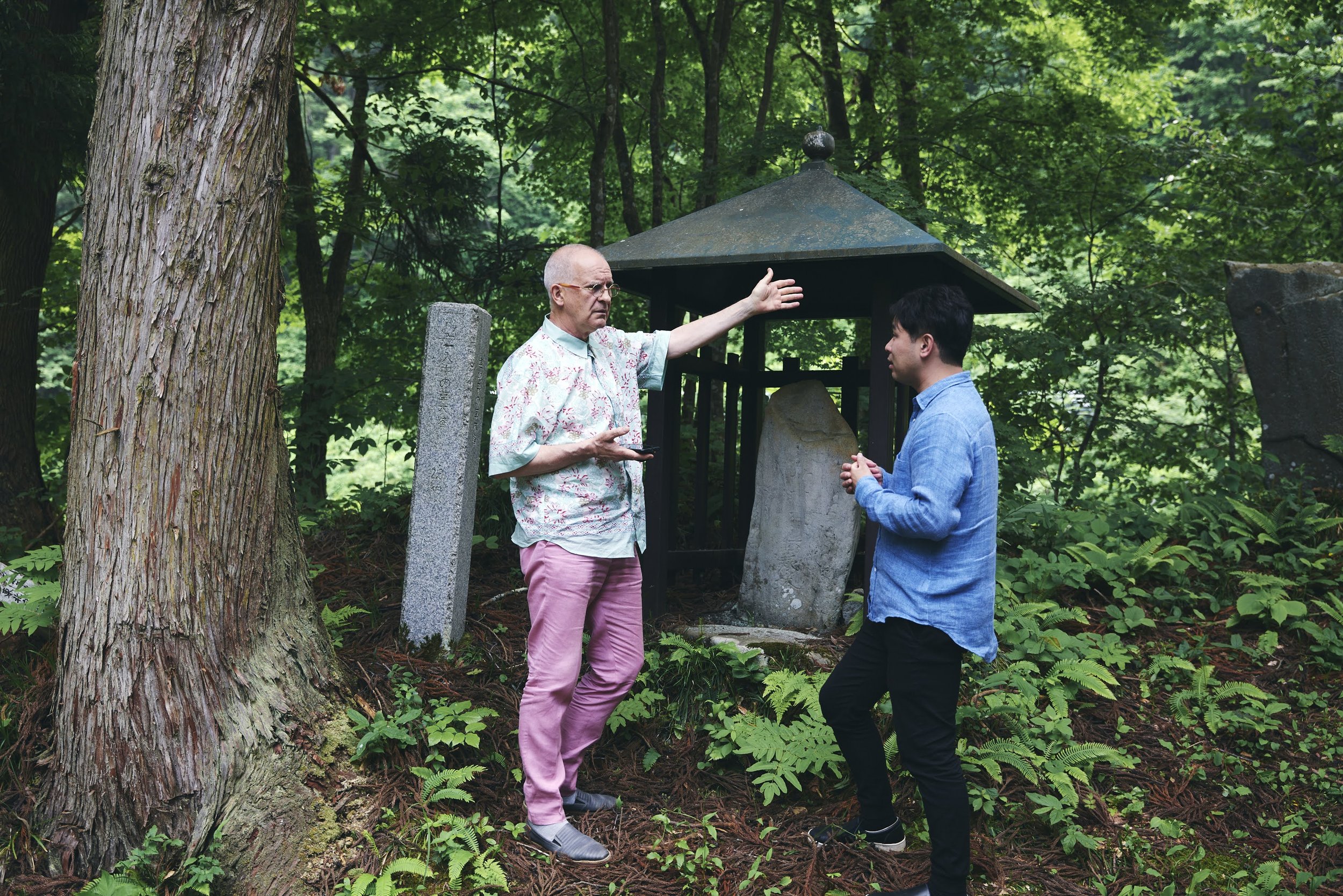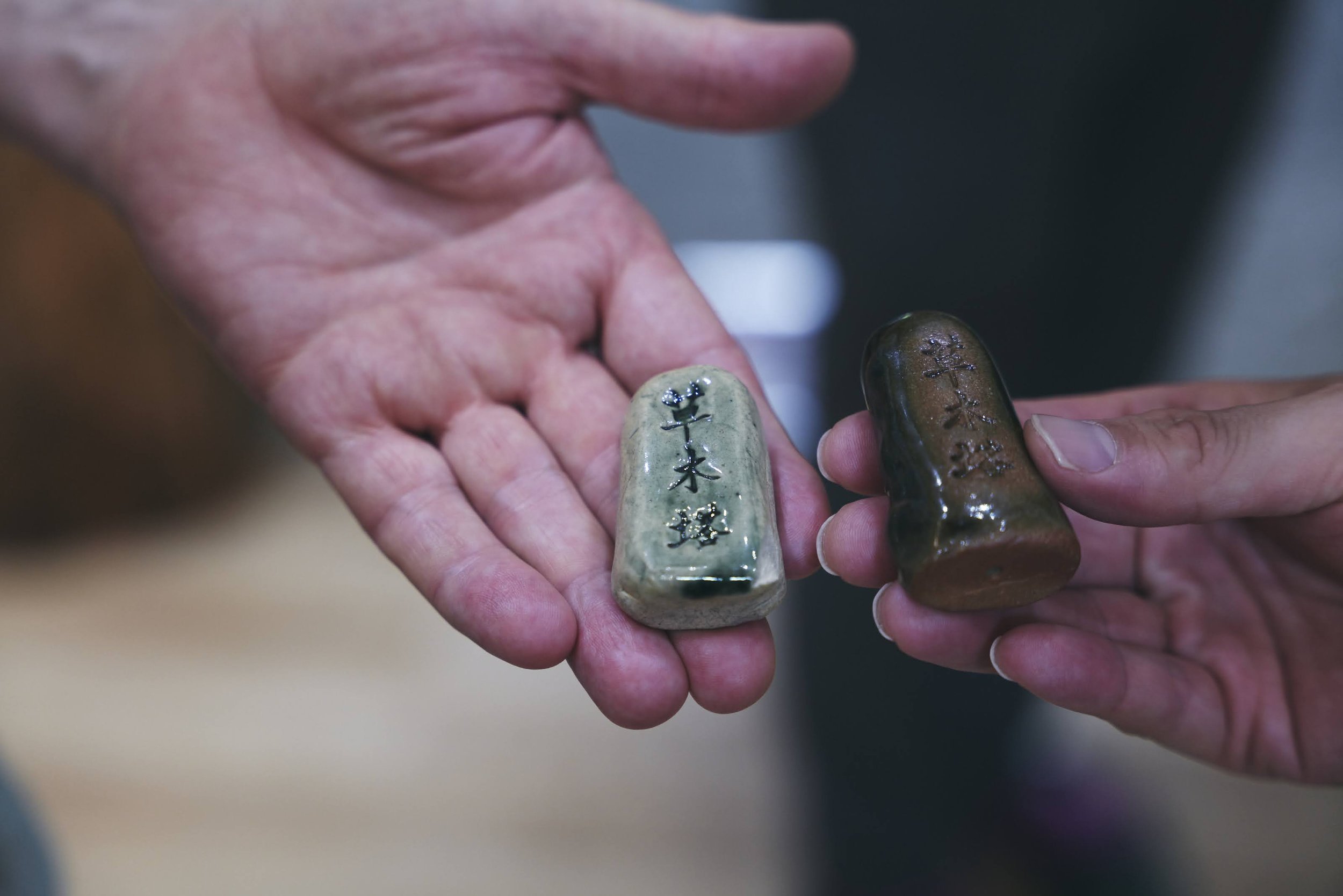Plants and Trees
A stone monument, two or three feet tall, with a simple inscription stood before me. It read: “plants and trees.” Somokuto, as they are known in Japanese, are monuments concentrated mainly in Okitama, a region in southern Yamagata Prefecture in Tohoku, the northern part of Japan’s main island of Honshu. Adam Fulford shares more.
Finding the true nature of somokuto in Yonezawa
A somokuto monument inscribed with the Chinese characters for “plants and trees” stands in a forest on the outskirts of Yonezawa City. (Photo: Plat Yonezawa)
A stone monument, two or three feet tall, with a simple inscription stood before me. It read: “plants and trees.” Somokuto, as they are known in Japanese, are monuments concentrated mainly in Okitama, a region in southern Yamagata Prefecture in Tohoku, the northern part of Japan’s main island of Honshu.
I first became aware of somokuto in 2014, when I visited the small community of Nakatsugawa, in the town of Iide, also in Yamagata. I was there as a judge in a national beautiful village contest, and my hosts felt that somokuto might interest visitors.
I was certainly intrigued. Although the phrase somoku (plants and trees) occurs in Buddhist sutras, I was told that the stone monuments were erected by members of the local community, mostly in centuries past and without the direct involvement of shrine or temple representatives.
But for what purpose? At the time, relatively little information was available about somokuto online, but I interpreted them in my own way, as an opportunity to say “please” or “thank you” when entering or leaving the forest.
Later, I became a community consultant in Iide and started to consider the souvenir potential of somokuto. Under the guidance of a local pottery instructor, I made several batches of ceramic mini-somokuto.
With his help, I also made a batch with a group at Denden, a facility in Iide for those with intellectual disabilities.
But I still knew little about the origins of somokuto. And so, when Ruth Jarman of Jarman International invited me to Yonezawa to spend an afternoon learning about somokuto with Yohei Sano, an expert on the subject, I leaped at the chance.
Left: The oldest somokuto in Yamagata dates back to 1780 and is found in the Tazawa district of Yonezawa City.
Right: Ceramic mini-somokuto produced by Denden in Iide Town. (Photos: Plat Yonezawa)
Sano and I went first to Shiojidaira, the site of a once-thriving logging community in the Tazawa district of Yonezawa. Here, I saw the oldest of the 140 somokuto in Yamagata (there are only about 20 elsewhere in Japan). It dates back to 1780.
In those days, the forests of Shiojidaira were a source of “official” firewood and timber for Yozan Uesugi (1751–1822), a famous local lord whose later admirers would include US President John F. Kennedy. After Uesugi’s large mansion in Edo (now Tokyo) burned to the ground in 1772, timber from Shiojidaira would have been used to rebuild it. A few years later, more would have been needed after a big fire in Yonezawa.
For the people of Shiojidaira, a bare mountainside must have been shocking. Have we done something unforgivable? Anxious thoughts of this kind may have culminated in the erection of the first somokuto as a requiem, perhaps, for lost greenery.
Sano explained that, as the years went by, interpretations of somokuto began to shift. They came to be seen as an opportunity to express gratitude to the forest, and later as a reminder to safeguard nature.
My own view of somokuto may be somewhat out of sync with their true nature, but if I’d never encountered them, I wouldn’t have had the chance to get to know Sano, an ideal recipient of the small gift that I gratefully presented to him: a mini-somokuto from Denden.
Spirit of Yozan
The death of a close friend at college prompted Tohoku native Hiroaki Miyajima to pursue a career in advertising in the United States. Having returned to his hometown of Yonezawa, Yamagata Prefecture, in 2011, he is now part of a local business collective whose mission is to secure the town’s future prosperity. The Ukogi collective, established by Miyajima and several other Kojokan graduates, channels the spirit of Yozan in a bid to grapple with the issues facing Yonezawa and many of Japan’s rural areas.
How a samurai reformer inspires a new generation to take the lead and succeed
Listen to this story:
The death of a close friend at college prompted Tohoku native Hiroaki Miyajima to pursue a career in advertising in the United States. Having returned to his hometown of Yonezawa, Yamagata Prefecture, in 2011, he is now part of a local business collective whose mission is to secure the town’s future prosperity.
Place of Inspiration
Those not familiar with the Tohoku region, in the far north of Japan’s main island of Honshu, may be excused for being unaware of Yonezawa. But this landlocked town has inspired some of the nation’s most successful executives and one of the United States’ best-loved presidents. When John F. Kennedy was asked after his inauguration to name a Japanese figure whom he respected, to the surprise of the Japanese press corps he answered with the name Yozan, a clan leader who ruled the domain of Yonezawa during the 18th century.
Yozan Uesugi inherited a Yonezawa impoverished by profligate leaders and entrenched interests. Heavily influenced by his teacher, Heishu Hosoi, who saw it as the duty of rulers to put the interests of their domains above their own, Yozan swore an oath to restore the prosperity of Yonezawa and its people. He is highly admired for his radical economic reforms and being an exemplar of frugality.
In Yonezawa, the figure of Yozan looms large, and in no place more so than Kojokan High School, which he founded in 1776. The school seeks to instill a sense of service and importance of action summed up by one of Yozan’s most famous sayings: “For all things, try and you will succeed; do not try and you will not succeed. Lack of success is merely due to lack of trying.”
Intellectual Foundation
The Ukogi collective, established by Miyajima and several other Kojokan graduates, channels the spirit of Yozan in a bid to grapple with the issues facing Yonezawa and many of Japan’s rural areas. The name Ukogi is that of a deciduous shrub that Yozan promoted for use in making hedgerows, while the edible leaves can serve as a food source in times of famine. Use of the shrub symbolizes the importance of creative thinking and self-reliance, which Yozan stressed to his people.
Collective member Yohei Sano, who helps with the family fish market, has a background in legal philosophy and studies local history in his free time. Known as The Professor, he is a quiet contrast to the ebullient Miyajima and provides Ukogi’s intellectual foundation. Synthesizing the virtues and lessons of the past, he is developing the philosophy of a restoration based on sustainable development and employing public–private sector cooperation. Put simply, Sano said, “I want to make Yonezawa a place to which the next generation will want to return and make their life.”
The speed of change in Japan can often be glacial, but Yozan overcame the powerful social and economic forces of the 18th century to restore the prosperity of Yonezawa. Ukogi is aiming to instigate a second restoration and make Yonezawa a place that once again inspires beyond its borders.
Of Sake and Scythe Weasels
On November 4, 2021, an evening of culture, flavors, and learning took place at Kojima Sohonten Co., Ltd., Japan’s 13th-oldest sake brewery, established in 1597. Located in Yonezawa, Yamagata Prefecture, Kojima Sohonten is best known for its award-winning Toko sake. When you’re inside the brewery, the dedication and craftsmanship of more than 400 years of brewing seem to infuse the darkened wood of the huge barrels. On this day, however, amid the ongoing travel restrictions, it was innovation—along with multiple cameras—that helped bring the historical setting to travel writers on the east coast of the United States.
A surprising view of Tohoku with Alex Kerr and John Gauntner
Listen to this story:
On November 4, an evening of culture, flavors, and learning took place at Kojima Sohonten Co., Ltd., Japan’s 13th-oldest sake brewery, established in 1597. Located in Yonezawa, Yamagata Prefecture, Kojima Sohonten is best known for its award-winning Toko sake. When you’re inside the brewery, the dedication and craftsmanship of more than 400 years of brewing seem to infuse the darkened wood of the huge barrels. On this day, however, amid the ongoing travel restrictions, it was innovation—along with multiple cameras—that helped bring the historical setting to travel writers on the east coast of the United States.
Jarman International KK proposed the special webinar as a way to satisfy the wanderlust of frustrated Japan lovers overseas. We used our Covid-induced thinking time to bring together sake expert John Gauntner and author Alex Kerr to speak about what makes the Tohoku region so culturally distinct. The event was hosted by the Japan National Tourism Organization’s New York office and co-produced with JR East Marketing & Communications, Inc., known as JEKI.
Flavorful Culture
What better way to connect with viewers than to send delicious sake to each, along with recipes which perfectly match the various brews? Perhaps having Gauntner and Kerr intertwine the story of Tohoku with an engaging discussion about sake flavor profiles and bouquets?
The evening proved to be the perfect appetizer for the travel boom we expect will hit next spring. Gauntner taught participants how to properly heat and taste sake, suggested pairings for various cuisines, and vividly showed how the flavor profile of each bottle is deeply connected to the region, its rice, and the craftsmanship.
Lost Japan author Kerr brought to life the mystical side of Tohoku. Do you know what bait to use to catch a kappa (river sprite) in Iwate? Have you heard the chilling tale of the kamaitachi (scythe weasel)?
Travel Preview
Tohoku is also filled with beautiful hamlets, forgotten by time, and is home to some of the few remaining views of old Japan, such as the now-rare red pines and the last surviving garden of the Heian Period (794–1185). As people around the world connect with Tohoku through innovative online events, we expect more travelers to follow the lead of Dr. Edwin O. Reischauer, former US Ambassador to Japan, and venture to the “other side of the mountain.” Tohoku is the cradle of Japanese civilization, and is sure to wow any visitor with colorful festivals, thatched villages, folklore, and, of course, plenty of wonderful sake.






